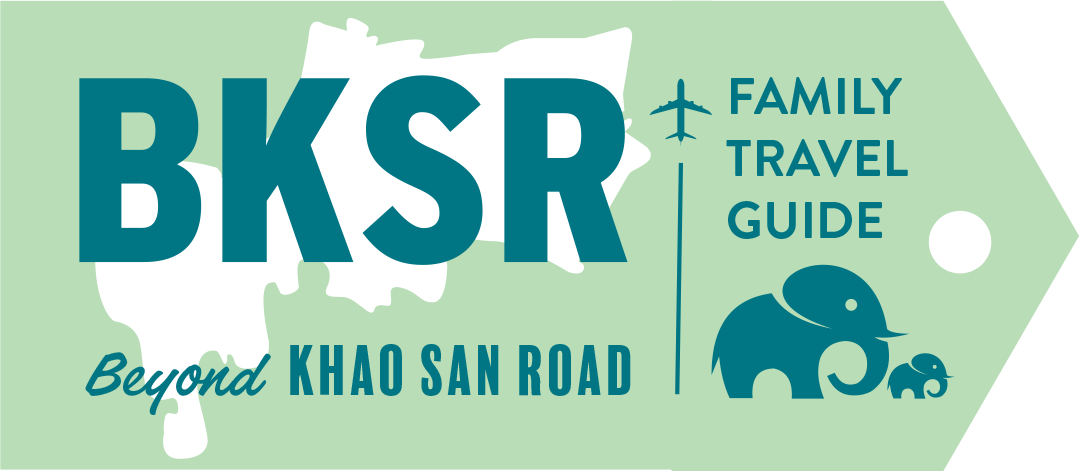When planning our voyage through Patagonia, Ushuaia always had a sense of being the end of the line, terra incognita, the distant domain of the early explorer. Just looking at its position on the map makes you realise how close you are to simply running out of south. From there, only a handful of islands separate you from the Antarctic. Frankly, we were surprised Google Maps didn’t read “Here be monsters”. If you plan to journey to Ushuaia with kids, the city at the end of the world has so much to offer, with its rugged beauty and Fuegian charm.
Arriving in Ushuaia, it’s easy to understand its allure. With its slightly weathered facade, this unique town sits amidst the stunning backdrop of the snowcapped southern Andes. It’s a place where incredible wildlife is just a stone’s throw away, and the breathtaking Tierra Del Fuego National Park is within easy reach. Ushuaia offers a blend of natural beauty and adventure, making it a captivating destination for travellers, young and old.
The heart of Ushuaia for visitors is Av. San Martin, close to the Tourist Port. This bustling avenue is lined with various outdoor stores, gift shops, cafes, and restaurants. It’s worth noting that Ushuaia is comparatively expensive by Argentine standards. This is partly due to a ‘tourist tax’ on goods sold on the main street and because everything sold in Ushuaia must travel a long, costly journey by truck or shipping container to reach this remote location.
Are you planning a visit to Ushuaia with kids? Our comprehensive guide is designed to help you make the most of your time in this enchanting town. From exploring the rich natural beauty to discovering family-friendly activities, we’ve covered all you need to know for a memorable and enjoyable stay in Ushuaia. Please read on for tips, recommendations, and insights that will make sure your family’s trip is both fun-filled and unforgettable.
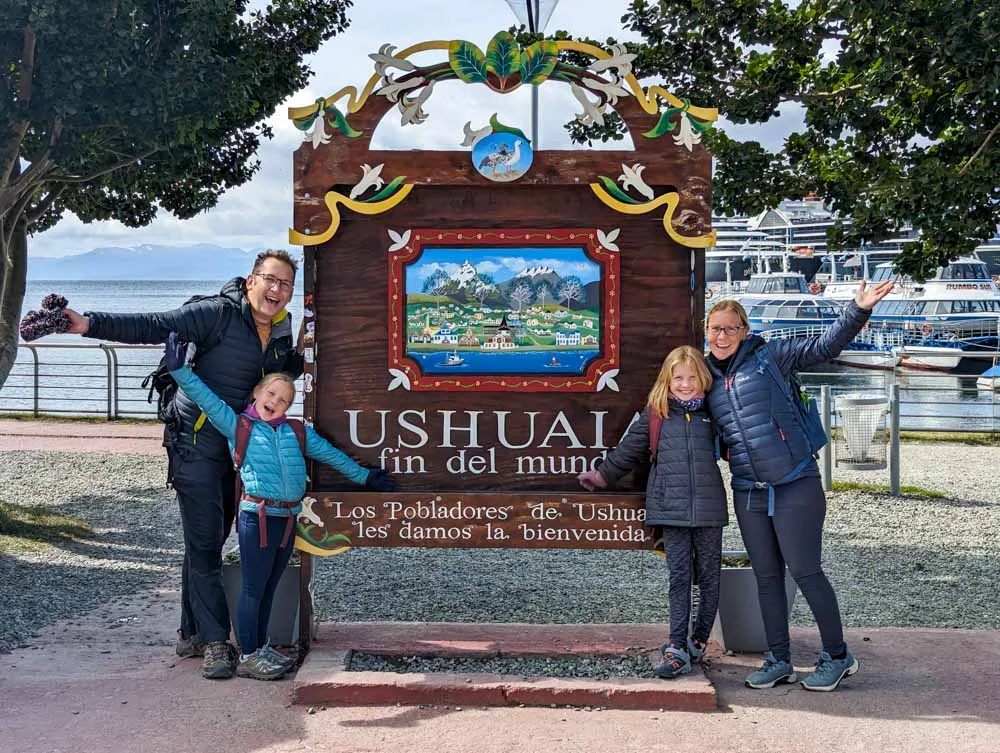
Our Map For Exploring Ushuaia With Kids
When To Visit Ushuaia With Kids
When you are as far south as Ushuaia, you can expect cold weather at any time of year. We visited at the height of summer; rarely did the temperature get into double figures, we had bitter winds, and it snowed twice in the week we were there.
Unless you have children who are used to extreme cold or you are visiting for skiing, then we recommend visiting Ushuaia with kids between late spring and early autumn, so mid-October to mid-February. This will give you the best weather, but you will not miss out on the dramatic snowy mountains.
What To Pack When Visiting Ushuaia With Kids
Just the usual Patagonia hit list! Sun cream, sun glasses, good walking shoes/boots, and lots of layers.
The wind can be sharp, especially if you take a boat trip, and our girls were wrapped up in a t-shirt, jumper, down jacket, bobble hat, buff, and gloves, which seemed to do the job.
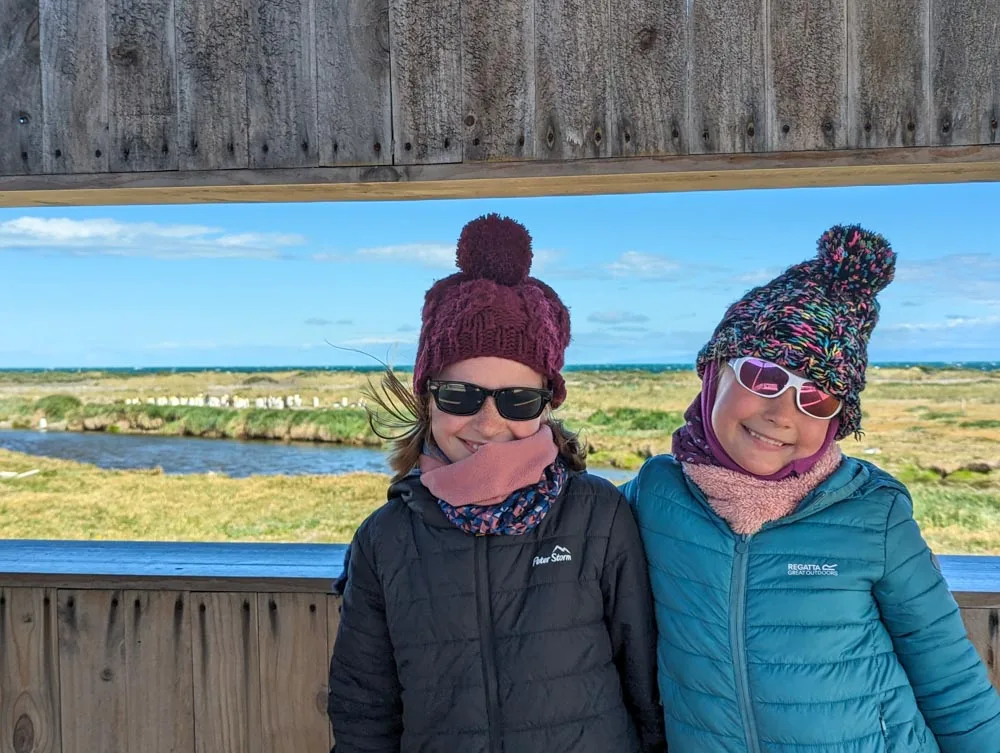
The only thing that we did not need was bug spray. It seems not even mosquitos will venture this far south.
If you forget anything then there are plenty of outdoor shops in town which carry childrens clothes and boots.
The bottom fell off one of Eva’s walking shoes while we were here, and we were able to find a replacement with little bother. Be warned, between the weak Argentine Pesos, hefty import taxes, and the distance things have to travel, nothing you buy will be cheap.
The F Word
Sorry to drop the f-bomb, but we need to talk about the Falklands. This is only relevant if, like us, you are visiting Ushuaia and are British.
One thing you can’t get away from when visiting Ushuaia is the strength of feeling about the Falkland Islands and the 1982 conflict, which went rather disastrously from the Argentine perspective. We will not get the history of these islands or even “Top Gear” infamous run-in with veterans when they visited, but we will say that reminders of the firm local belief that they should be Argentine territory are everywhere in the city.
From street art to shopping signs, billboards, car stickers, t-shirts, the local airport name, bank notes, and even the town sign, you can barely move for pictures of the islands and ”Malvinas son Argentinas” proclamations. While none of this jingoism is explicitly anti-British, it is still hard not to take it as such.
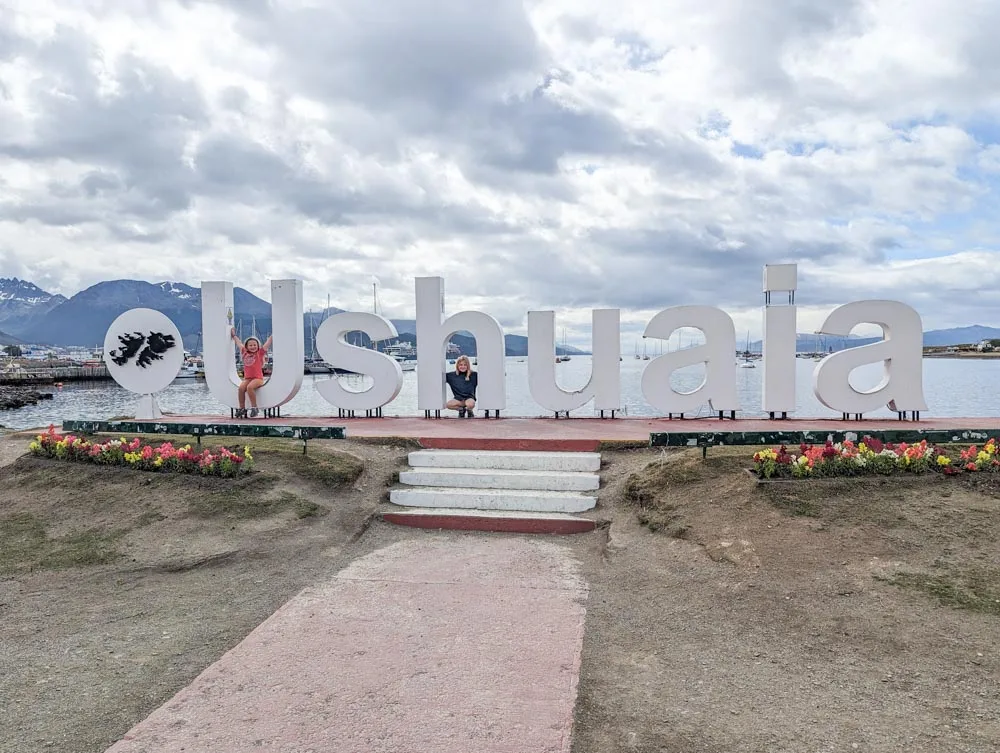
We would say that in our four days in the town, we experienced zero animosity when we said we were British and at no point felt like we had to hide where we were from.
Of course, we were careful with what we said and didn’t raise the subject with anyone (“don’t mention the war”), but there is no reason to expect any issues when you visit.
Getting To Ushuaia With Kids
Due to its geography as the southernmost city in South America, reaching Ushuaia is not a simple or quick task.
By Air
Flying into Ushuaia Airport has to be one of the most stunning arrivals in the world. Surrounded by snowcapped peaks and adjacent to the Beagle Channel, we struggle to think of any airport with a better setting.
The aiport connects directly to several places inside Argentina, such as El Calafate and Buenos Aires, but not from Bariloche suprisingly. There are multiple flights daily during peak season although these do reduce during the winter.
As is so often the case in Patagonia, it is not simple to fly from anywhere in Chile to Ushuaia. For example, to fly the short distance from Punta Arenas you have to connect via Puerto Montt, Santiago and Buenos Aires and this trip will take about 30 hours.
Suddenly the bus trip seems tempting!
By Sea
A steady stream of cruise ships comes through Ushuaia every day during the summer months, and this daily influx of passengers is the lifeblood of the town’s tourist industry. It is no suprise that all the major tour opperatours are located next to where the boats dock.
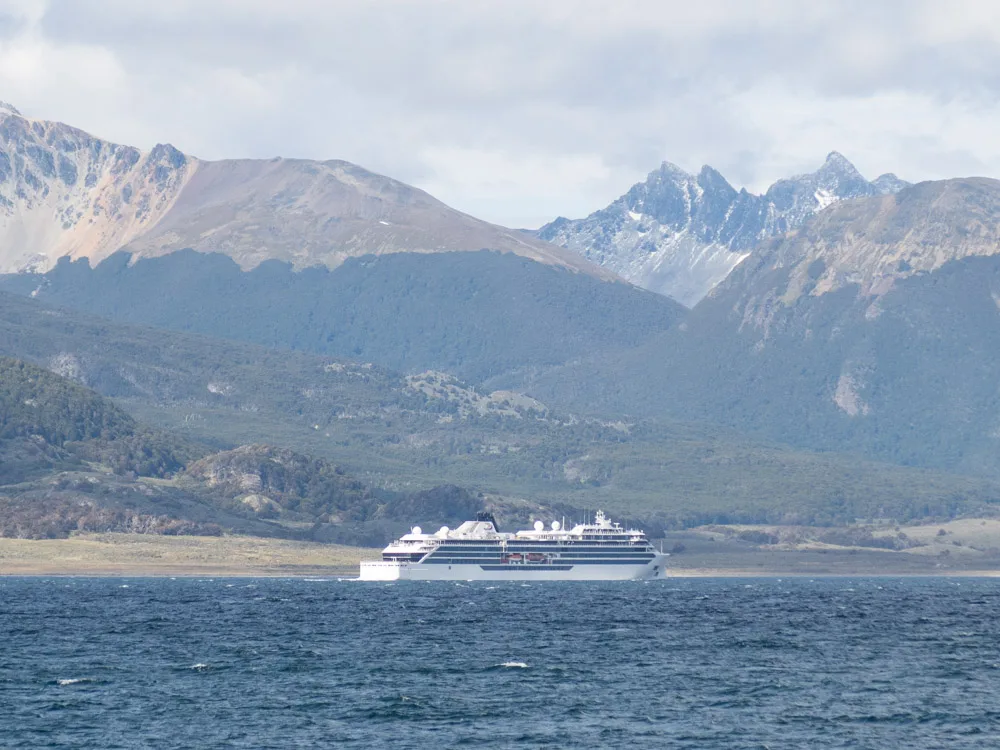
We had heard whispers that a car ferry operated daily from Puerto Williams, and you could also take a 34-hour ferry from Punta Arenas to Ushuaia, but neither services were running when we visited.
By Land
If you are driving south to Ushuaia from Puerto Natales and Torres Del Paine, then Route 3 and Route 257 are tarmacked all the way and are a straightforward drive, apart from the car ferry, border crossings and the occasional suicidal guanaco that you have to keep an eye out for.
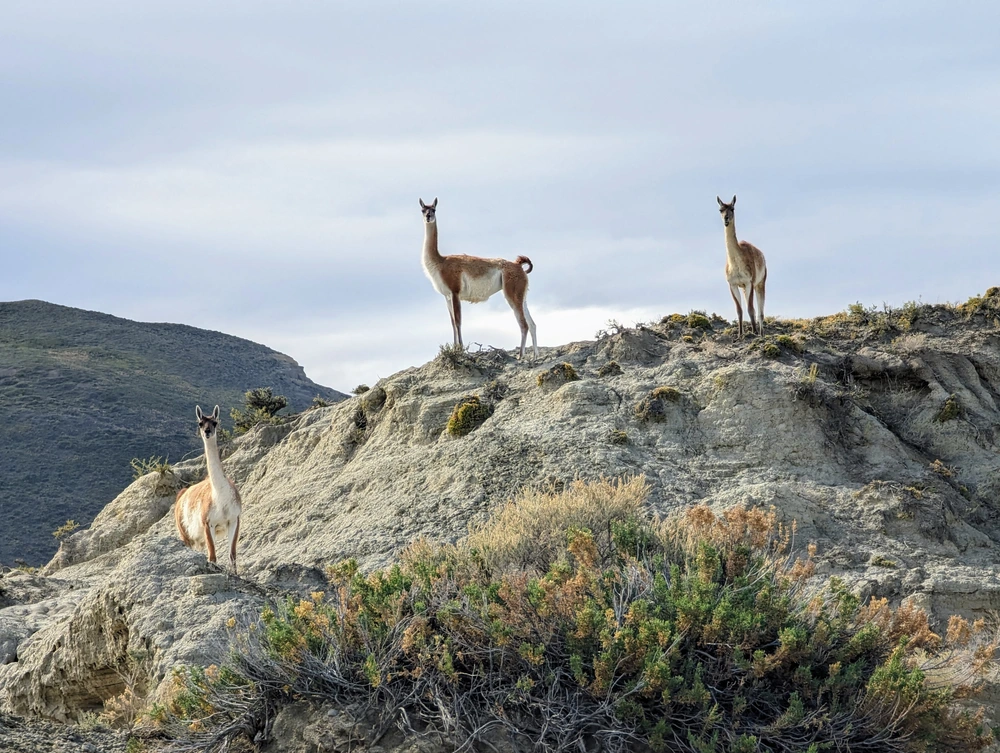
To reach Ushuaia, you must cross the Magellan Straight, which you can do at the Primera Angostura Crossing. This crossing is unusual because you can’t book in advance, and the timetable is somewhat meaningless; you turn up and wait. When we passed through, three ferries were constantly shuttling back and forth over this narrow stretch of the straight, and it took us about forty minutes to get on board, and the journey was about an hour. The cost for a car was CLP$ 19,000/£16/USD 20; passengers were free. You purchase your ticket when you have boarded the boat.
If you are driving south from El Calafate or Rio Gallegos, then you will cross at the Magellan Straight at the same place but you will have to contend with two border crossings, not one.
If you are driving south to Ushuaia from Punta Arenas, then you can either head north and take the crossing described above or take the Porvenir car ferry. The car ferry sails once a day, and the time varies with the tide. Tickets cost CLP$ 43.500/£36/USD 57, and you can see the timetable here.
When you leave the ferry at Porvenir, the Y-71 is tarmacked only a short distance before turning into gravel for 90 km until you join Route 257. As Patagonian gravel roads go, it is not too bad, but this was the road where we had our first flat tyre of the journey!
That said, heading this way does have one big benefit: it is only a short detour to see the king penguin colony at Parque Pingüino Rey!
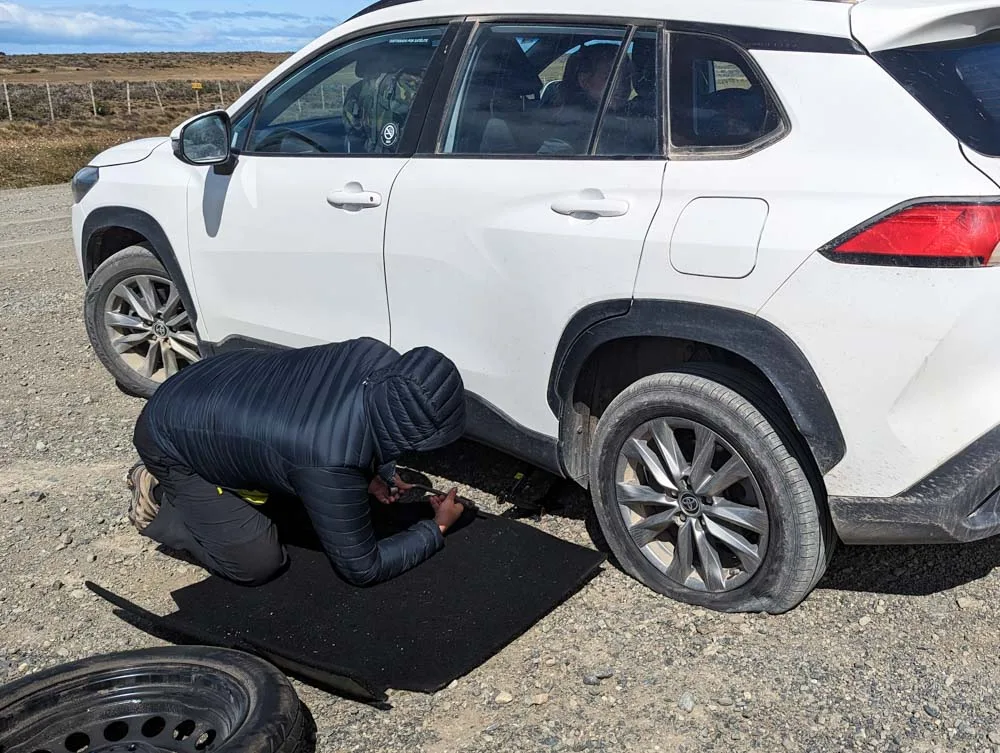
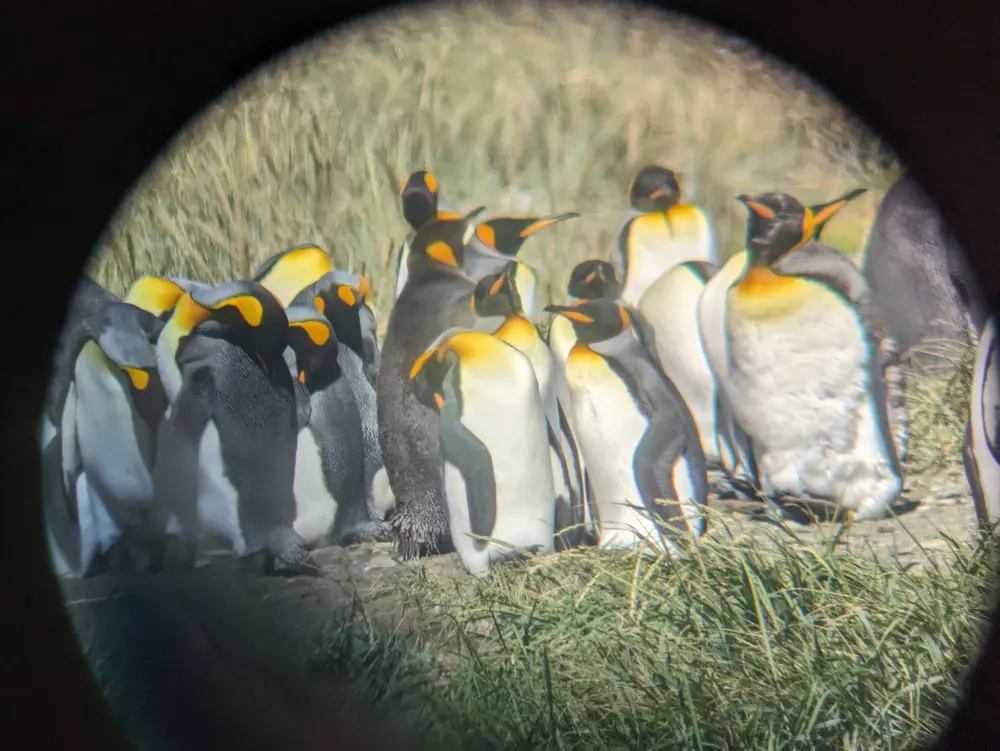
The main road from San Sebastian to Ushuaia, Ruta 3, is a very easy to drive by Patagonia standards. It is tarmacked all the way and has several beautiful places to stop off.
If you are travelling by bus, there are direct services to Ushuaia from Punta Arenas, El Calafate and Rio Gallegos. Check Rome to Rio for information.
Where To Stay And Getting Around Ushuaia With Kids

Just so you know, all prices within Argentina are given in GBP and USD only, not Argentine Pesos.
Currently, inflation in Argentina is running wild, and any prices we post will be out of date within days.
Av. San Martin in Ushuaia, the main tourist strip located near Puerto Turistico, where cruise ships dock, is the bustling heart of the city’s tourist area.
This lively street encapsulates the essence of a busy tourist destination, featuring an array of the usual tat shops, numerous cafes and restaurants catering to various tastes, and outdoor equipment stores.
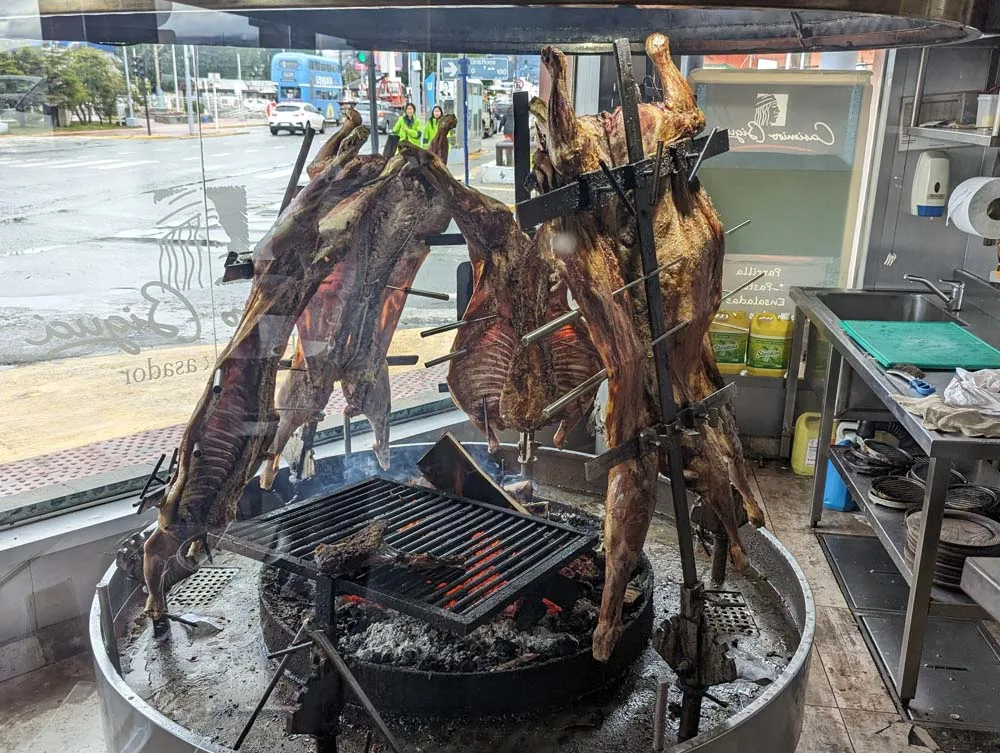
Where you stay in Ushuaia will depend on how mobile you are. If you have your own transport, reasonably priced Airbnbs are all over the city. If not, then staying in one of the hostels or hotels close to Av. San Martin will put you in an easy walking distance to everything you may need during your stay, as well as the boat trips and Museo Marítimo.
When we visited, no Ubers were operating but there were plenty of taxis in the town if you need to get further afield.
The Tierra Del Fuego National Park entrance is about a 12km/25-minute drive from the town to the east on RN3. Astonishingly, there is no public transport between the city and the national park. However, private shuttles run between the central bus station and the national park, as well as a few other destinations.
Tickets are sold at the main desk at the central bus station and cost around £14/USD 17 return. They depart three times in the morning, return three times in the afternoon and take you to several points in the park as it is a long way down a dusty road from the main entrance to the start of any walks.
Things To Do In Ushuaia with Kids
Unlike Punta Arenas or even El Chalten, there is much more to Ushuaia than simple proximity to a national park, although Tierra Del Fuego is undoubtedly a big attraction!
The Maritime Museum
Just a short walk from the eastern edge of Av. San Martin is a former prison turned museum, catchily titled Museo Maritimo y Del Presidio de Ushuaia.
Like its title, the Maritime Museum crams a lot in. It covers the culture and history of the nomadic aboriginal people who lived in the region for 6000 years, the history of the European settlers who came to the area and essentially wiped out the aboriginals, the history of prisons, its own history as a prison, the voyage of the Beagle and other explorers, the Falklands Conflict, and it is an art gallery!
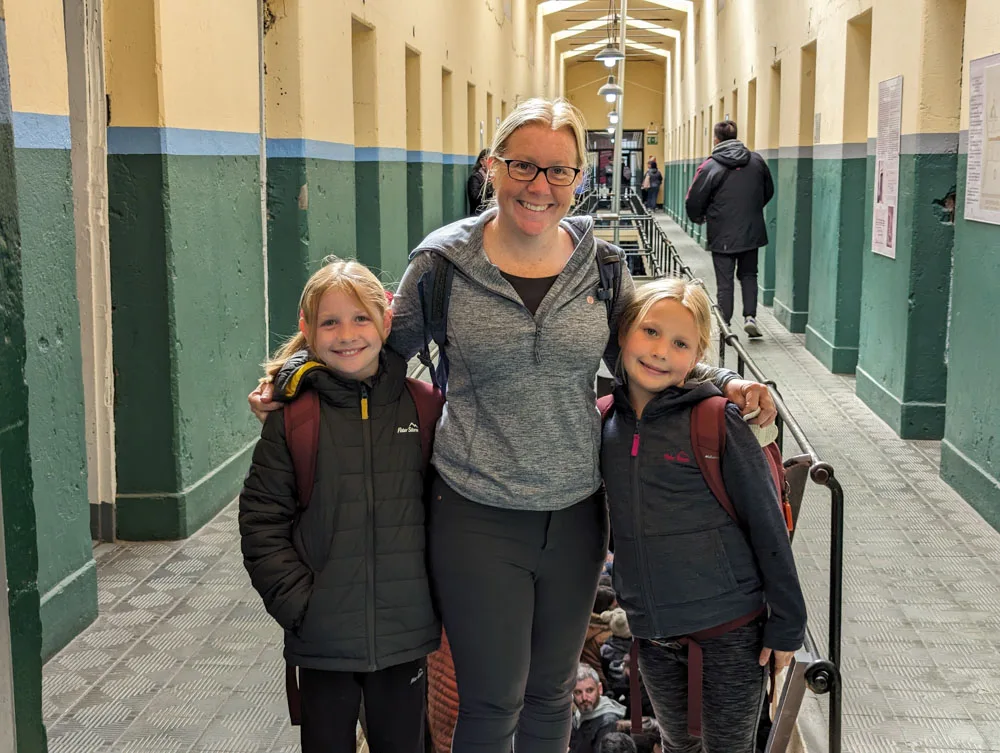
If this all sounds too much for one visit, fortunately, tickets to Museo Maritimo are valid for 72 hours, so you can come back and tackle it again. We certainly found it all too much to absorb in one go.
The museum opens at 10 am; we arrived at 11 am and caught the large queue of people coming for the guided tour, which starts at 11.30. The tour is only in Spanish, so we skirted around the group and explored at our own pace. Tickets cost £12/USD 14 for adults, and kids under 12 are free. In total, we spent just over 3 hours here.
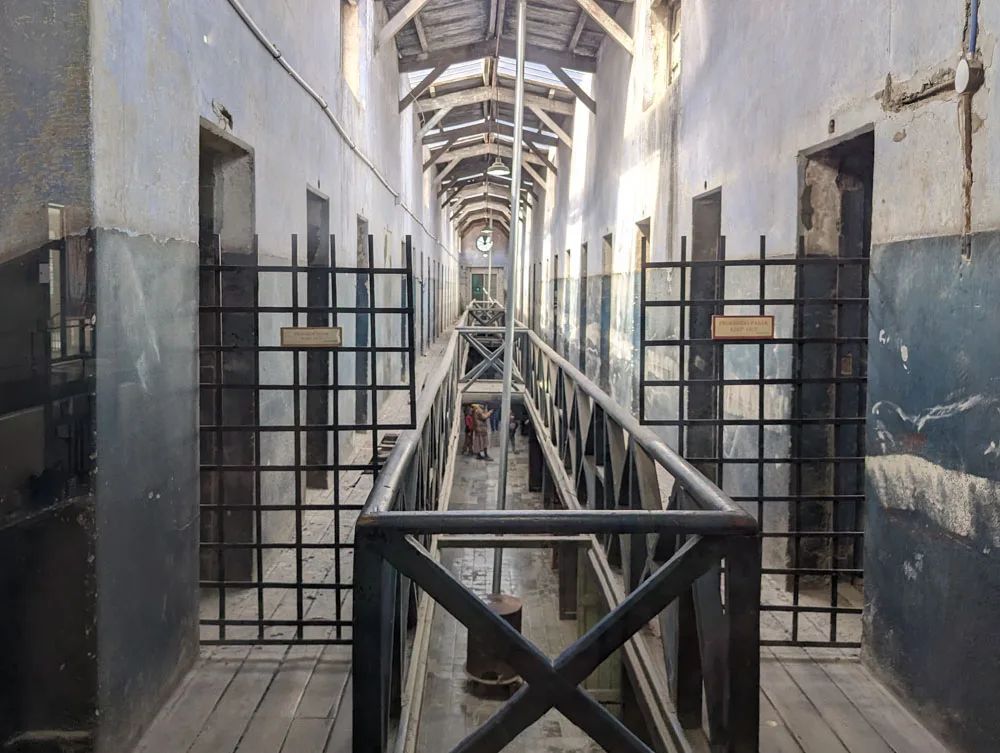
All exhibits are in Spanish and English, except somewhat strangely, the section on the Falklands conflict.
Boat Trips
Between the main high street and from the main street, you will find a collection of kiosks selling tickets for various voyages up the Beagle Chanel.
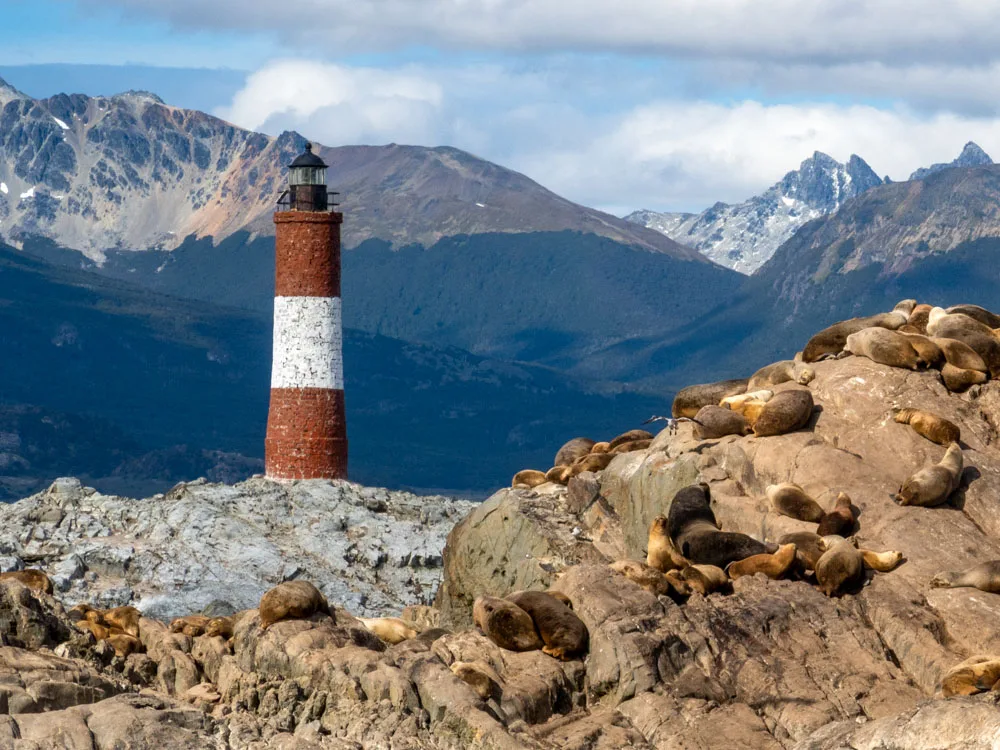
Three different trips are available:
- Green Route – The Green Route takes about two hours and is to the romantically named “Lighthouse at The End Of The World”, where you will see sea lions and cormorants. £35/44 USD per adult, £20/25 USD kids under 12.
- Red Route – This five-hour trip starts at the lighthouse, and then it takes you further up the channel to Martillo Island to see the Magellan penguin colony there. This is the option we took, and we booked through Terramar Tourismo. We had a great experience; it was our first time seeing Magellan Penguins, and the lighthouse is such an iconic landmark of the city that it should not be missed! The trip costs £50/60 USD per adult, £25/30 USD kids under 12.
- Blue Route – This third option takes 9-hours. It starts with a coach trip close to Isla Martillo, where you take a much smaller boat over the channel, and you can then walk amongst the penguins. This is an eye-watering £190/USD 240 per adult and £95/ USD 120 for kids under 12, and it books up several weeks in advance in the high season. If you are heading up the East Coast on your trip, you can get a much better experience for a fraction of the cost at Monte Leon National Park, Punta Tombo or Puerto Deseado.

Interestingly, having shopped around several of the opperators, they all charge the same price, and they all share customers. If one boat is full, then you may be put on another company’s boat, or if there are two half full boats they will combine them.
Departure time changes with tide, and the trip may be cancelled if too windy, so it is best to book it on your first day in town in case it gets pushed back.
We sailed on a calm day, and even then, the journey back up the channel to Ushuaia against the wind was still rough enough to give most of the children and a couple of the adults on board a nasty dose of seasickness.
Overpriced snacks and drinks are available on board; you can pay by card but only while close enough to the city for the card machines to have a signal, so bring some cash. Alternatively, you can bring your drinks and food with you.
We were advised by the lady who sold us the tickets to arrive an hour before departure to ensure seats upstairs for the best view. We got there nice and early and bagged a great table. We were glad we made the effort as the downstairs was packed, plus we had great scenic views along the Beagle Channel. However, whenever we stopped to see the wildlife, our view was blocked by other passengers standing on the deck taking photos, so you will need to wrap up, embrace the cold and head outside.
Be sure to wrap up warm, the wind on the channel can be cutting.
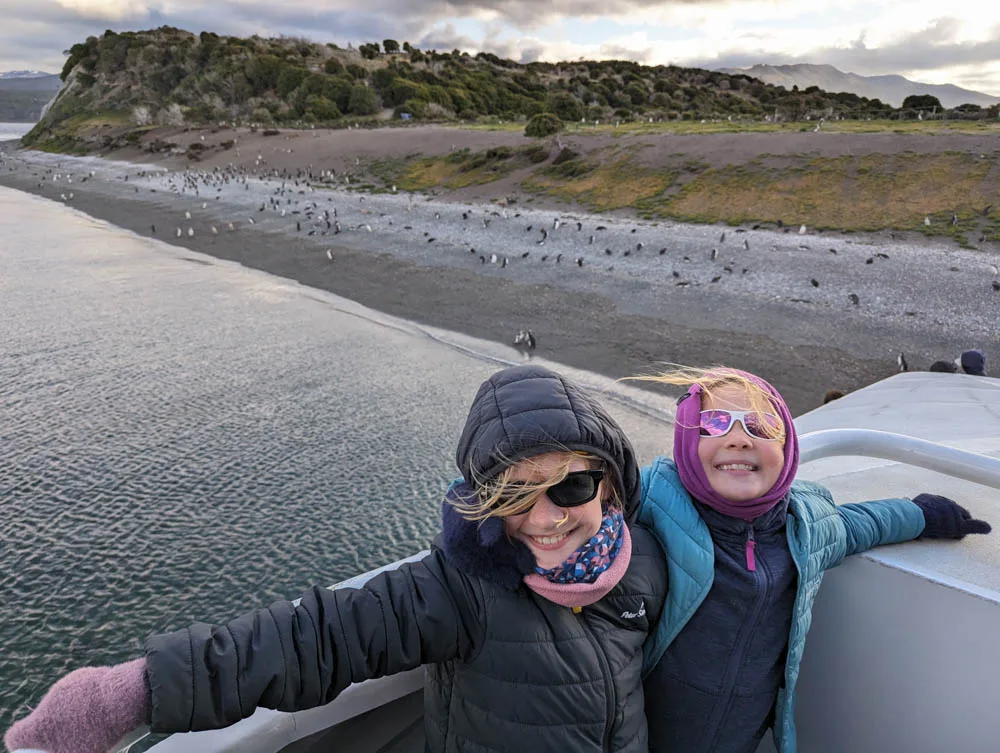
End of the World Train
Not getting to do this was one of our big disappointments of the trip. The End of the World Train (Officially called The Southern Fuegian Railway) was booked up weeks in advance, and by the time we knew what dates we would be in Ushuaia, we had missed our chance!
Built 70 years ago using prison labour to fetch wood back to the town, the 50-minute journey travels the last 7 kilometres of the original prisoner’s train route.
The departure point is located near the main entrance to the national park, 8 kilometres west of Ushuaia, so don’t think you depart from the city!
The train winds through lush forests and past rushing rivers, the train’s charming vintage carriages and narrated history provide an immersive experience, blending scenic beauty with a glimpse into Ushuaia’s intriguing past.
To take the journey, you also need to buy tickets to the Tierra Del Fuego National Park, which you can do here. Be warned, the national park website is a bit of a scrap heap to navigate.
Tierra Del Fuego National Park
Ushuaia has much to offer when visiting with kids, but Tierra Del Fuego National Park is the jewel in the crown. This pristine wilderness offers a unique opportunity for young explorers to connect with nature, with its lush forests, serene lakes, and dramatic coastline, the park provides a picturesque backdrop for hiking, wildlife spotting, and picnicking.
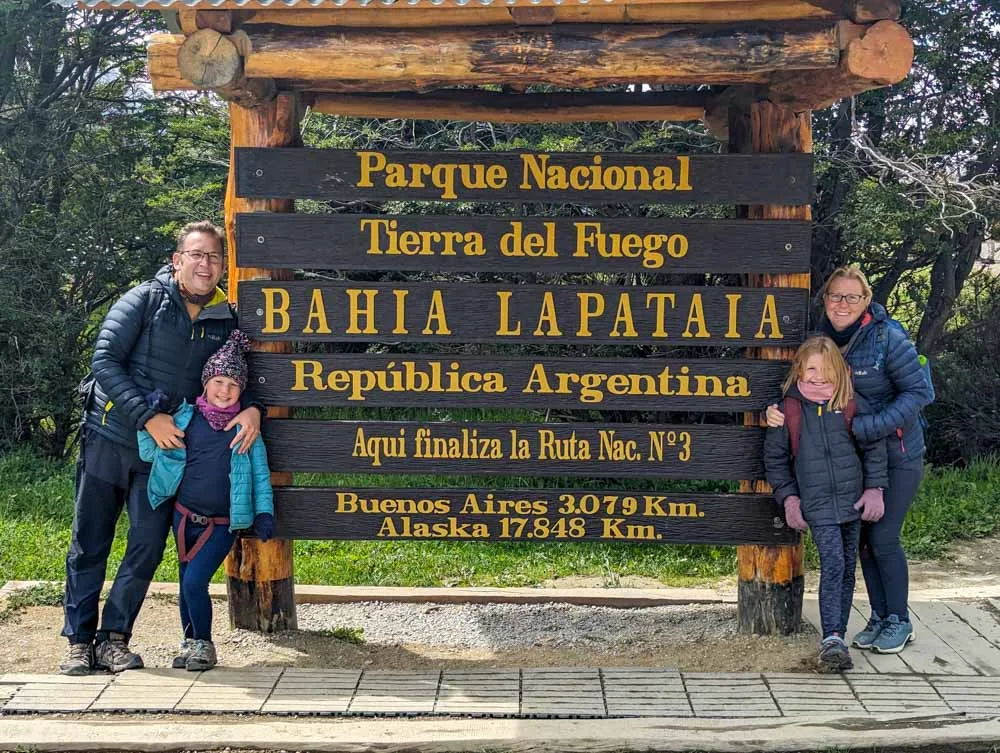
Where to Book Tickets
Like many of Argentina’s most popular national parks, Tierra Del Fuego requires tickets for entry. You can purchase tickets in advance online here or when you arrive at the park gates. We recommend booking them online as you get all the faffery of passport numbers out of the way!
If you book online, you need to present the booking confirmation when you arrive at the park, and they will print your physical tickets. There is a phone signal at the park entrance, but it is always worth having the confirmation downloaded to your phone anyway.
When booking your visit to Tierra Del Fuego National Park, you can book to visit on a second day with a 50% discount. This follow-up visit must be within 72 hours of your first entry, and you will need to keep your tickets from the first visit to present them when you arrive a second time.
Tickets for one day cost £12/15 USD per person over 5 years old. Kids under five are free.
What To Expect and Family Walks
Tierra Del Fuego National Park stands as a true gem in Patagonia, matching the best the region has to offer with its stunning landscapes.
While exploring the park during our Patagonian journey, we found it to be less accessible for families than others, with large sections not suitable for children. However, it still offers ample opportunities for family exploration.
With its diverse flora and fauna, breathtaking scenery, and a range of hiking trails, the park can easily provide a full and enriching two-day itinerary for families looking to immerse themselves in the natural beauty of this unique part of the world.
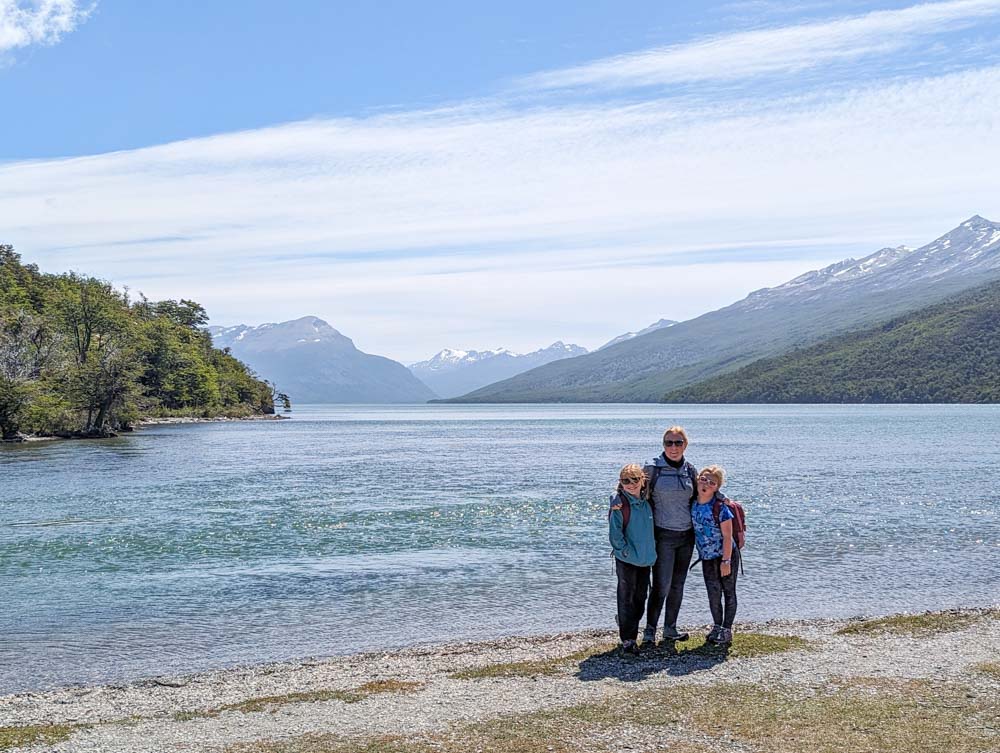
After entering Tierra Del Fuego National Park, one of the first stops for many visitors is the Centro de Visitantes Alakush. This visitor centre is easily accessible by car and offers a range of amenities, including a large café, clean toilets, and a souvenir shop.
An informative exhibit, presented in both English and Spanish, provides insights into the formation of the park, its geology, history, and the native inhabitants and is a great starting point for understanding the park’s natural and cultural significance with your kids.
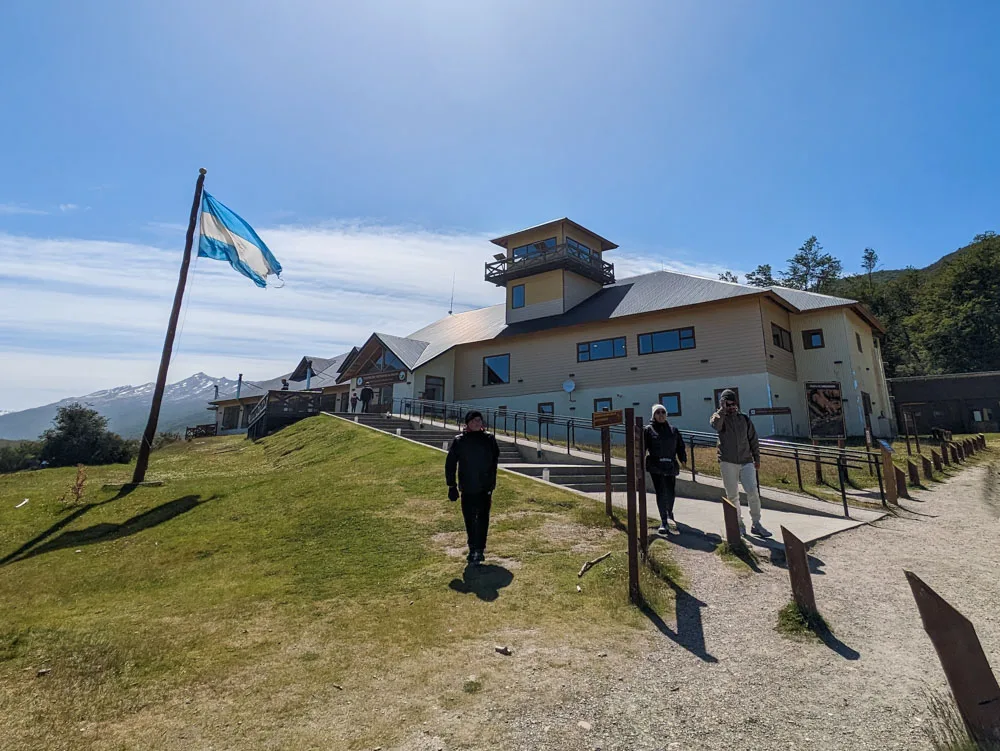
Close to the centre is the start point of a beautiful, relatively easy family walk alongside Lago Acigami that takes you through a primaeval feeling forest all the way to the border with Chile.
The next popular destination within Tierra Del Fuego National Park is Bahia Lapataia. This spot features a large parking area, though the portaloo toilets here are often less than desirable. Conveniently, there’s a coffee van nearby for a quick refreshment.
Bahia Lapataia is a prime location for some iconic photo opportunities, including the famous sign marking the end of Route 3, which stretches a staggering 3045 km all the way from Buenos Aires. It’s a symbolic spot that represents the end of the road in the literal sense.
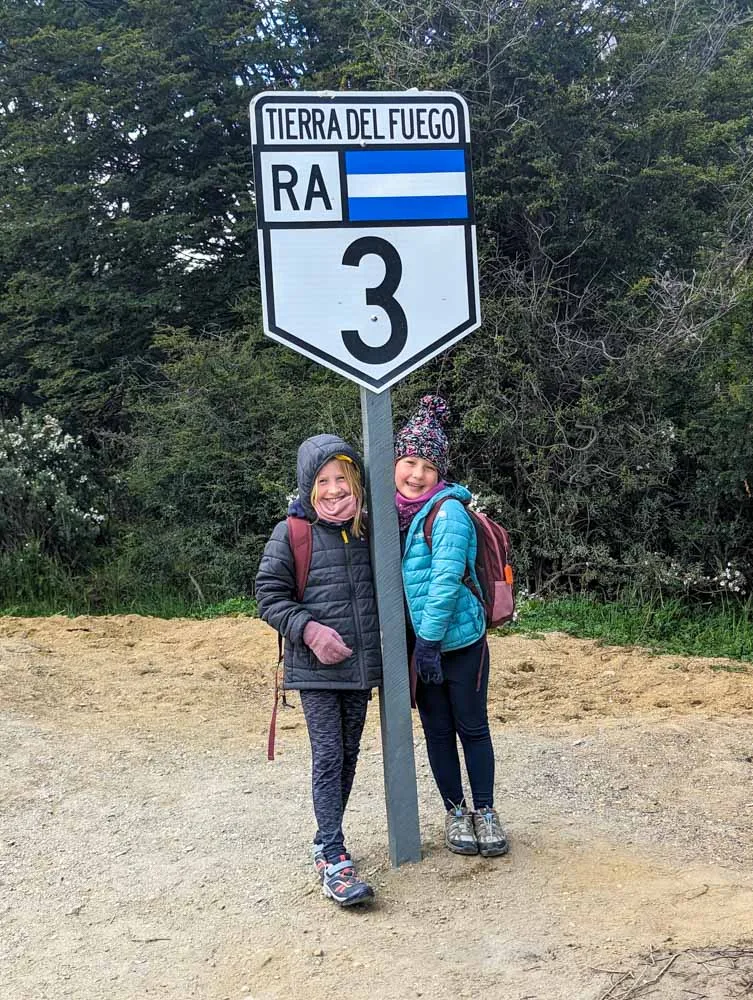
This is also the starting point of a short walk around a raised section of path that explores the history of the aboriginal people who used to live in this area, and a great walk along the side of Bahia Lapataia also begins here.
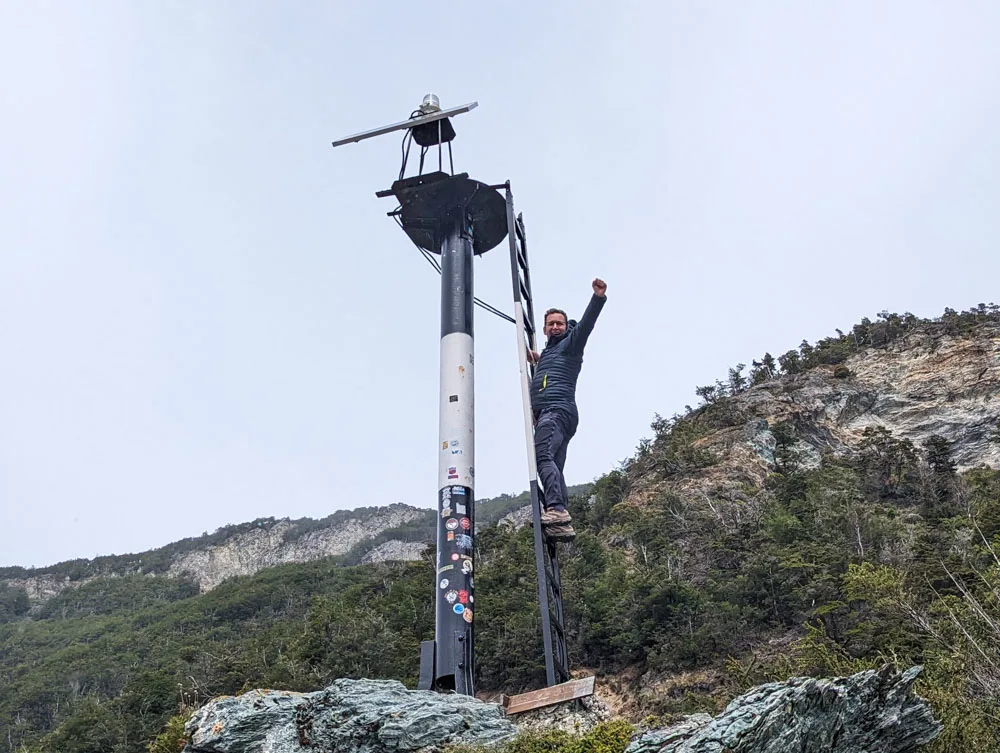
Family Rafting/Kayaking
If you want a bit more adventure on your visit, several companies offer rafting experiences in the park. We didn’t get a chance to do this ourselves, but we met a family who did and said it was an incredible, if chilly, experience.
The main tour operator in the town is Canal, who offer a full day experience, including transfers and lunch, for £125/USD 160 per adult and £90/USD 110 for kids under 12.
The minimum age is 5(!), which is by far the lowest we have found in all of Patagonia. In most places, 12 years old is the youngest tour operators will take due to insurance limitations.
You can see the full route the tour takes here:
Have We Missed Anything To Do In Ushuaia With Kids?
For us, Ushuaia was a symbolic stop on our Patagonia epic. It was as far south as we were going on this trip (although the girls were very keen to keep going to Antarctica!) and was the beginning of the end of our 7000 km drive through this unique part of the world.
We thoroughly enjoyed our stay here, and we hope you do too. If you think we have missed anything to do in Ushuaia with Kids or anything here is outdated, please let us know in the comments below.
The Spencer Family
